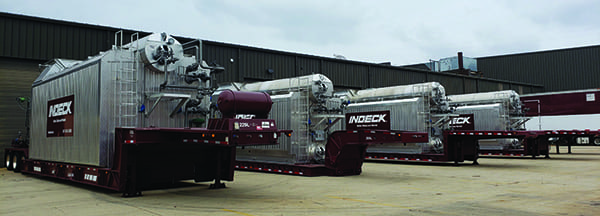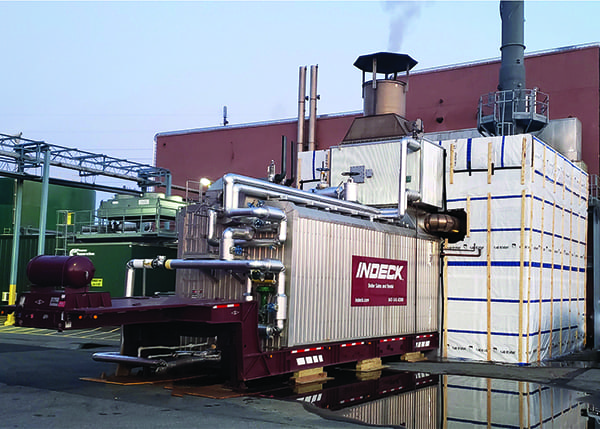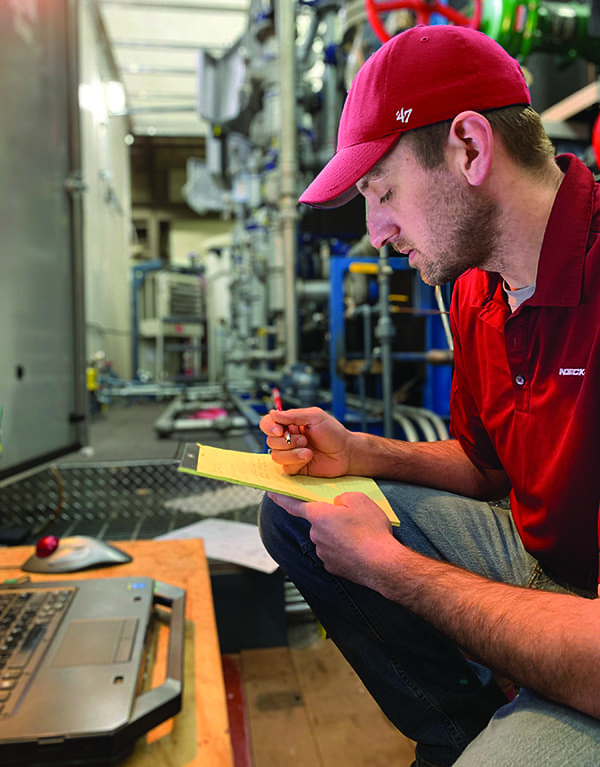When the Storm Strikes, Will You Be Ready?
Is your plant’s natural disaster preparedness plan leaving your site vulnerable? This article provides some best practices to help you prepare for the worst.
At some point in a plant’s life, there will inevitably be a need for temporary steam. Out of the many reasons a plant could need a rental boiler, natural disasters are undoubtedly one of the more stressful causes.
With any unplanned outage or power deficit, time lost is money lost. In the wake of a natural disaster, it is critical to restore your plant’s operating capacity as quickly as possible. Although every plant operation manager hopes their facility is out of the path of Mother Nature, an optimistic outlook is insufficient in protecting your facility against extreme weather and other unpredictable events.
With the assistance of Indeck’s emergency rental service, facilities equipped with a comprehensive and well-practiced natural disaster preparedness plan are able to efficiently and safely restore their plant’s power capacity after a natural disaster occurs. Incorporating the guidelines below will help ensure your plant’s natural disaster preparedness plan is sufficiently comprehensive, so that you can quickly and safely bring your plant back online after Mother Nature strikes.
Know Your Facility and Its Emergency Plans
The most effective time to prepare for a natural disaster is before one occurs. When it comes to reducing plant downtime, having staff well-versed in your facility’s natural disaster preparedness plan is just as critical as the plan itself. Emotions can run high in times of crisis, and keeping a checklist of items that need to be addressed is highly effective in ensuring there are no oversights in your facility’s pre- and post-emergency event procedures.
A natural disaster preparedness plan with a limited scope often overlooks smaller tasks, such as securing objects to minimize debris from high winds and unplugging all non-essential electronic equipment to reduce the potential for power surges from a plant’s contingency uninterrupted power supply (UPS). For critical equipment, it does not hurt to double-check if protection procedures have been properly implemented. Where applicable, the enclosure around your plant’s boiler(s) should be reinforced to prevent any damage from debris, downed power lines, ash, extreme temperatures, and other unusual conditions. With severe weather that brings high winds and flooding, the best practice is to house your boiler in a place that is less exposed to flooding or standing water.
A natural disaster can be anything from a hurricane, earthquake, blizzard, or even a wildfire. Different natural disasters require different procedures to ensure your plant is properly protected. Even though emergency preparedness plans may look different from region to region, all exhaustive plans include steps to safely and effectively manage your plant’s operations before, during, and after an emergency event.
Talk with Partners Early
The underlying goal of a facility’s natural disaster plan is to bring the facility online as quickly as possible. If your plant is in a region highly susceptible to seasonal events like hurricanes or wildfires, your natural disaster preparedness plan should include conversations with your steam power provider to build an emergency rental package before storm season begins.
If you purchased your equipment from a single-source steam/hot water provider, such as Indeck, they will have a detailed history of your plant’s equipment. From this information, they will be able to build out a flexible emergency rental package that is easily amended to match the exact steam/hot water deficit caused by the storm.
 |
|
1. This image shows several trailer-mounted boilers from Indeck’s rental boiler fleet. Courtesy: Indeck Power Equipment Co. |
Open communication is key in delivering the correct equipment needed. During severe weather seasons, both you and your provider should keep an eye on the storm’s progress. Most emergency rental boiler providers can deliver trailer-mounted boilers (superheat or saturated steam) in a few days (Figure 1). Effective emergency preparedness plans have protocol in place that allow for quick identification and communication of a plant’s temporary power requirements to their temporary steam provider.
Additionally, partnering with a single-source steam and hot water provider allows for integrated emergency service scheduling with their in-house transportation and rental departments. With designated service technicians for each of our clients’ accounts, Indeck can seamlessly adjust service start times based around our clients’ schedules; if the storm forecast changes, and equipment delivery needs to be pushed forward or backward, our Emergency Service department can accommodate these changes without creating any scheduling conflicts.
Prep Your Site for Housing Temporary Steam
Prior to a temporary boiler arriving on-site, certain steps need to be taken to ensure the plant can safely host the temporary boiler. Trailer-mounted and skid-mounted boilers need to sit on a clear, level area that has not been structurally compromised from flooding, ash, debris, or other issues. The designated on-site location must also be structured to meet safety and ventilation requirements of the region/country.
 |
|
2. The boiler housing (doghouse) protects equipment from rain and subsequent water damage. Courtesy: Indeck Power Equipment Co. |
Comprehensive natural disaster preparedness plans will typically have a predesignated area for emergency power equipment. This area is usually the on-site location least susceptible to structural damage, weathering/erosion, standing water, and other problems (Figure 2). Additionally, if high winds have created debris or ash, this location is easily cleared out in time for equipment arrival.
As a single-source steam power provider, Indeck provides its clients with a contingency planning quotation that includes a forecast of installation and utility requirements, which allows our clients to proactively prepare their site. With this resource forecast, Indeck’s clients can account for the required tie-ins, so the emergency boiler installation and start-up processes run as quickly and smoothly as possible.
Establish a Realistic Timeline for Recovery
Depending on the nature of the natural disaster, your facility may be performing on-site generation anywhere from a few days to more than a month. In the wake of a natural disaster, geographic areas are still highly susceptible to the elements—leaving the region’s buildings and infrastructure exposed when they are most vulnerable.
Earthquakes bring with them the potential for aftershocks; fires can cause ash to linger in the air for weeks; and after a hurricane, severe storms and flooding are almost an inevitability. During this time, it is critical that regular audits are performed to ensure your temporary boiler is operating to your facility’s needs, and your site’s permanent boiler(s) recovery is on-track. Be sure to monitor weather forecasts and make any adjustments necessary to your plant’s recovery timeline.
Keep in mind, during this time, your facility may be short-handed. Employees who work at your facility will almost certainly have been personally impacted by the storm. Consequently, they may be unable to return to work immediately. A plant’s post-disaster recovery timeline will account for a reduced labor force as well as post-event vulnerabilities. This, in turn, will allow a plant’s operational manager to set realistic expectations as to when all permanent equipment will be fully operational.
Before Restarting Your Boiler
Like the start-up of your emergency temporary equipment, ensuring your permanent boiler(s) can be turned on safely is key. If your steam power equipment is housed inside a thermal plant, ensure the foundation and boiler settings have not been compromised from water or debris.
If there is risk that your boiler was exposed or submerged in water, the boiler casing should be removed, cleaned, and thoroughly dried. If compromised insulation is found during casing removal, it should be replaced. A thorough check and cleaning of your boiler’s internal components for water damage or sediment/dust/ash should be conducted as well. All fixed components should be confirmed to be level.
Boiler components like pressure valves, temperature gauges, water shut-off valves, and other items should be cleaned, repaired, and dried where applicable. If any of your boiler’s parts need to be replaced, contact a steam power provider such as Indeck for replacement parts. If you purchased your boiler from a single-source provider, boiler part replacement may be covered under warranty through the company’s in-house boiler parts store.
 |
|
3. A service technician is shown here performing testing to an Indeck mobile feedwater treatment trailer. Courtesy: Indeck Power Equipment Co. |
If there is reason to believe any control system digital or electrical components were impacted by water damage, consult with the manufacture to run a program reset/diagnostic report prior to operating. Indeck’s service technicians (Figure 3) are happy to assist with this process for all previously purchased Indeck equipment.
Improved Peace of Mind
When a natural disaster strikes, it comes at a great expense—financially, physically, and emotionally. Having a natural disaster preparedness plan is key in reducing time lost and minimizing physical damage when an unexpected outage occurs. An easy-to-follow, well-practiced contingency plan addressing how to safely prepare your plant is critical to quickly and safely bring your plant’s equipment back online.
Partnering with a full-service steam and hot water provider to create a comprehensive emergency temporary steam package for your facility can bring peace of mind to plant operators and added value to a plant’s emergency preparedness plan.
With Indeck’s comprehensive in-house services that include emergency boiler rentals, expedited transportation, and emergency start-up services, plant operators can rest easy knowing the support Indeck brings not only minimizes plant downtime, but also brings their facility and their community one step closer to being whole in the wake of a natural disaster. ■
—Aaron Naylor is the service manager for Indeck Power Equipment Co.